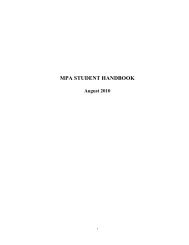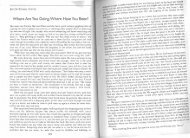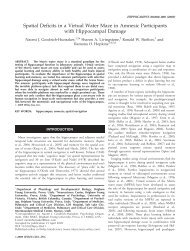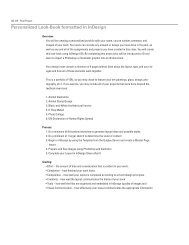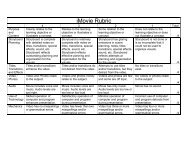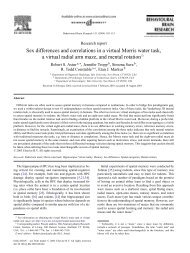Currency substitution in selected African countries - Emerald
Currency substitution in selected African countries - Emerald
Currency substitution in selected African countries - Emerald
Create successful ePaper yourself
Turn your PDF publications into a flip-book with our unique Google optimized e-Paper software.
country where currency <strong>substitution</strong> is prevalent, <strong>in</strong>terest rate (both real and nom<strong>in</strong>al)<br />
changes would be uncerta<strong>in</strong> due to the <strong>in</strong>stability of the money demand.<br />
Researchers exam<strong>in</strong>ed the existence of currency <strong>substitution</strong>s and its adverse<br />
effects on policy mak<strong>in</strong>g for both developed and underdeveloped <strong>countries</strong>[2]. Three<br />
dist<strong>in</strong>ct methods are used to identify the presence of currency <strong>substitution</strong>. Thomas<br />
(1985) argued that the ratio of real domestic balances to real foreign balances should be<br />
negatively related to the domestic nom<strong>in</strong>al <strong>in</strong>terest rate and positively to the foreign<br />
nom<strong>in</strong>al <strong>in</strong>terest rate if currency <strong>substitution</strong> exists <strong>in</strong> those economies. Other<br />
researchers used optimiz<strong>in</strong>g framework with both domestic currency and foreign<br />
currency as assets to identify currency <strong>substitution</strong>s[3] (Selçuk, 2003; Agénor and<br />
Khan, 1996). The presence of currency <strong>substitution</strong> has been also tested by exam<strong>in</strong><strong>in</strong>g<br />
the stability of the money demand function as the presence of currency <strong>substitution</strong><br />
<strong>in</strong>creases the volatility of money demand (Darrat et al., 1996; Sharma et al., 2004).<br />
The latter approach is the one considered <strong>in</strong> this paper. It is an <strong>in</strong>direct way of<br />
<strong>in</strong>vestigat<strong>in</strong>g the existence of currency <strong>substitution</strong> <strong>in</strong> a country by pay<strong>in</strong>g attention to<br />
the changes that take place <strong>in</strong> the money demand for domestic currency. We consider<br />
this approach because the data on foreign monies circulat<strong>in</strong>g <strong>in</strong> the economy and<br />
foreign deposits of domestic residents are not available for the <strong>countries</strong> considered<br />
here. Moreover, this approach has an advantage because it accounts for both capital<br />
mobility and currency <strong>substitution</strong>. Recently, Prock et al. (2003) <strong>in</strong>vestigated the<br />
presence of currency <strong>substitution</strong> <strong>in</strong> Lat<strong>in</strong> America <strong>countries</strong> us<strong>in</strong>g this approach.<br />
They exam<strong>in</strong>ed the money demand function of Argent<strong>in</strong>a, Brazil and Mexico <strong>in</strong> a<br />
vector error correction model. Their f<strong>in</strong>d<strong>in</strong>gs <strong>in</strong>dicate that currency <strong>substitution</strong> is<br />
prevalent <strong>in</strong> all three <strong>countries</strong>, but it is more pronounced <strong>in</strong> Brazil and Argent<strong>in</strong>a than<br />
<strong>in</strong> Mexico. Also, Darrat et al. (1996) exam<strong>in</strong>ed the stability of money demand function<br />
for Japan while other researchers used a similar approach to study currency<br />
<strong>substitution</strong> <strong>in</strong> Asian develop<strong>in</strong>g <strong>countries</strong> (Sharma et al., 2004) and Mexico (Rodriguez<br />
and Turner, 2003).<br />
The stability of the money demand function is crucial to conduct an efficient and<br />
<strong>in</strong>dependent monetary policy. Haug and Lucas (1996) used a co-<strong>in</strong>tegration analysis to<br />
study the stability of the Canadian long-run money demand. They also estimated the<br />
parameters with the fully-modified estimation method us<strong>in</strong>g quarterly data from<br />
1953:1 to 1990:4, and observed a stable money demand function for Canada. Lutkepohl<br />
et al. (1999) studied the stability and l<strong>in</strong>earity of a German money (M1) demand<br />
function. They used smooth transition regression techniques capable of<br />
accommodat<strong>in</strong>g both smooth and sudden change <strong>in</strong> regression coefficients over<br />
time. Us<strong>in</strong>g quarterly data from 1960:1 to 1995:4, they noted that the relationship was<br />
l<strong>in</strong>ear and stable before 1990 and the monetary unification barely changed this<br />
relationship. Ibrahim (1998) us<strong>in</strong>g co-<strong>in</strong>tegration technique exam<strong>in</strong>ed the stability of<br />
money demand <strong>in</strong> Malaysia by consider<strong>in</strong>g both M1 and M2 and observed that M1 is<br />
unstable <strong>in</strong> the long run, while M2 is stable <strong>in</strong> the long-run but unstable <strong>in</strong> the<br />
short-run. Consequently, he concludes that us<strong>in</strong>g M2 as a target <strong>in</strong> monetary policy will<br />
be recommended provided that the policy makers figure out the structural break <strong>in</strong> the<br />
money demand. There are only few studies devoted to money demand <strong>in</strong> <strong>African</strong><br />
<strong>countries</strong> (for example see Agénor and Khan, 1996; Alami, 2001; and Elkhafif, 2003).<br />
Generally researchers exam<strong>in</strong>e whether currency <strong>substitution</strong> exists between<br />
domestic currency and US dollar, British pound, or Japanese yen. However, <strong>countries</strong><br />
<strong>Currency</strong><br />
<strong>substitution</strong><br />
617



